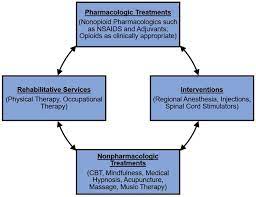The Importance of Effective Pain Treatment
Pain is a universal human experience that can significantly impact our quality of life. Whether it’s acute or chronic, physical or emotional, pain can be debilitating and affect our ability to perform daily tasks, work, and enjoy life to the fullest.
Effective pain treatment is crucial not only for alleviating immediate discomfort but also for preventing long-term consequences. Untreated or poorly managed pain can lead to a range of issues, including decreased mobility, sleep disturbances, anxiety, depression, and reduced overall well-being.
Types of Pain Treatment
There are various approaches to pain treatment, depending on the type and severity of the pain. Some common methods include:
- Medication: Over-the-counter or prescription medications can help manage pain by reducing inflammation, blocking nerve signals, or altering brain chemistry.
- Physical Therapy: Exercises and techniques aimed at improving mobility, strength, and flexibility can be beneficial for managing musculoskeletal pain.
- Acupuncture: This traditional Chinese practice involves inserting thin needles into specific points on the body to relieve pain and promote healing.
- Cognitive Behavioral Therapy (CBT): A psychological therapy that helps individuals identify and change negative thought patterns and behaviors associated with pain.
- Lifestyle Changes: Adopting a healthy lifestyle through proper nutrition, regular exercise, stress management techniques, and adequate sleep can play a significant role in managing chronic pain.
The Role of Holistic Approaches
In recent years, there has been a growing recognition of the importance of holistic approaches to pain treatment. These approaches focus on treating the whole person rather than just the symptoms of pain. Holistic methods may include:
- Mindfulness Meditation: Practicing mindfulness can help individuals become more aware of their thoughts and sensations related to pain without judgment.
- Nutritional Therapy: Certain foods and dietary supplements have anti-inflammatory properties that can help reduce pain and support overall health.
- Yoga and Tai Chi: These mind-body practices combine physical postures with breathing techniques to improve flexibility, balance, and relaxation while reducing stress-related pain.
- Hypnotherapy: By accessing the subconscious mind through hypnosis, individuals can address underlying beliefs and emotions that contribute to their experience of pain.
In conclusion, effective pain treatment is essential for improving quality of life and preventing long-term complications. By combining conventional medical treatments with holistic approaches that address the physical, emotional, and psychological aspects of pain, individuals can find relief and regain control over their well-being.
9 Effective Pain Management Strategies: From Cold Therapy to Sleep Hygiene
- Apply ice for acute pain to reduce inflammation and numb the area.
- Use heat therapy for chronic pain to relax muscles and improve blood flow.
- Practice relaxation techniques like deep breathing or meditation to manage pain levels.
- Stay active with gentle exercises like walking or swimming to maintain flexibility and strength.
- Consider over-the-counter pain relievers like ibuprofen or acetaminophen for mild to moderate pain.
- Consult a healthcare professional for proper diagnosis and treatment of underlying causes of pain.
- Explore alternative therapies such as acupuncture, massage, or physical therapy for pain relief.
- Maintain a healthy diet rich in anti-inflammatory foods to help reduce chronic pain symptoms.
- Get an adequate amount of sleep each night as lack of sleep can worsen perception of pain.
Apply ice for acute pain to reduce inflammation and numb the area.
Applying ice for acute pain is a simple yet effective tip to reduce inflammation and numb the affected area. The cold temperature helps constrict blood vessels, decreasing blood flow to the area and reducing swelling. Additionally, ice can temporarily numb the nerves in the area, providing relief from pain. This method is commonly used for injuries such as sprains, strains, or bruises to help manage pain and promote healing. Remember to always wrap the ice pack in a cloth or towel to prevent direct contact with the skin and limit application time to avoid potential skin damage.
Use heat therapy for chronic pain to relax muscles and improve blood flow.
Heat therapy is a beneficial approach for managing chronic pain as it helps relax muscles and improve blood flow to the affected area. By applying heat, whether through heating pads, warm baths, or heat wraps, individuals with chronic pain can experience relief and increased flexibility. The warmth from heat therapy can soothe sore muscles, reduce stiffness, and promote healing by enhancing circulation. Incorporating heat therapy into a pain management routine can provide a natural and effective way to alleviate discomfort and improve overall well-being.
Practice relaxation techniques like deep breathing or meditation to manage pain levels.
Practicing relaxation techniques such as deep breathing or meditation can be highly effective in managing pain levels. By focusing on slow, deep breaths or engaging in mindfulness meditation, individuals can promote a sense of calm and reduce the perception of pain. These techniques help relax both the body and mind, potentially decreasing muscle tension and stress that contribute to pain intensity. Incorporating regular relaxation practices into a pain management routine can provide natural and accessible ways to cope with discomfort and improve overall well-being.
Stay active with gentle exercises like walking or swimming to maintain flexibility and strength.
Staying active with gentle exercises such as walking or swimming is a valuable tip for effective pain treatment. Engaging in low-impact activities helps maintain flexibility and strength, which can alleviate pain and prevent further discomfort. These exercises not only promote physical well-being but also contribute to overall health and mental wellness. By incorporating regular movement into your routine, you can improve your quality of life and manage pain more effectively in the long term.
Consider over-the-counter pain relievers like ibuprofen or acetaminophen for mild to moderate pain.
When dealing with mild to moderate pain, it can be beneficial to consider using over-the-counter pain relievers such as ibuprofen or acetaminophen. These medications are commonly used to alleviate discomfort and reduce inflammation, making them effective options for managing various types of pain. It is important to follow the recommended dosage instructions and consult with a healthcare professional if the pain persists or worsens. Incorporating these over-the-counter pain relievers into your pain treatment plan can help provide relief and improve your overall comfort level.
Consult a healthcare professional for proper diagnosis and treatment of underlying causes of pain.
It is crucial to consult a healthcare professional for a proper diagnosis and treatment of the underlying causes of pain. A healthcare professional can conduct a thorough assessment to identify the root cause of the pain and recommend appropriate treatment options tailored to individual needs. By addressing the underlying issues contributing to the pain, individuals can receive targeted care that not only alleviates symptoms but also promotes long-term healing and improved quality of life.
Explore alternative therapies such as acupuncture, massage, or physical therapy for pain relief.
Exploring alternative therapies such as acupuncture, massage, or physical therapy can offer valuable options for pain relief. These modalities provide non-invasive and often holistic approaches to managing pain, addressing both the physical discomfort and potential underlying causes. Acupuncture targets specific points in the body to promote natural pain relief and improve energy flow, while massage therapy can help relax muscles, reduce tension, and enhance circulation. Physical therapy focuses on strengthening muscles, improving flexibility, and restoring function to alleviate pain and prevent future injuries. Incorporating these alternative therapies into a comprehensive pain treatment plan can offer individuals additional tools to enhance their well-being and quality of life.
Maintain a healthy diet rich in anti-inflammatory foods to help reduce chronic pain symptoms.
Maintaining a healthy diet rich in anti-inflammatory foods is a valuable tip for reducing chronic pain symptoms. Foods such as fatty fish, leafy greens, berries, nuts, and olive oil contain anti-inflammatory properties that can help alleviate pain and promote overall well-being. By incorporating these nutritious foods into your daily meals, you can support your body’s natural healing processes and potentially experience a reduction in inflammation-related pain. Remember, what you eat plays a significant role in managing chronic pain and optimizing your health.
Get an adequate amount of sleep each night as lack of sleep can worsen perception of pain.
Getting an adequate amount of sleep each night is crucial for effective pain treatment. Research has shown that lack of sleep can exacerbate the perception of pain, making it more intense and difficult to manage. During deep sleep stages, the body repairs itself and releases hormones that help reduce inflammation and regulate pain sensitivity. By prioritizing good sleep habits, individuals can not only improve their overall well-being but also enhance their ability to cope with and alleviate pain.




